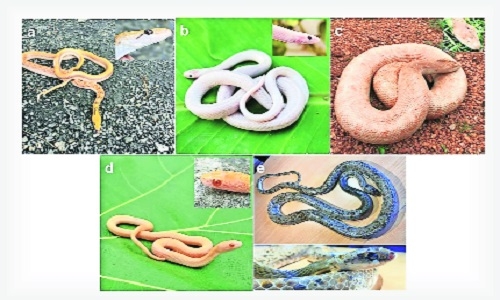Five snakes with rare albinism disorder found in Nagpur district
| Date :29-May-2024 |

Staff Reporter
Five cases of snakes catching rare diseases like Albinism and Leucism were reported within Nagpur district recently. A group of researchers — Kiran Bawaskar, Nitish Bhandakkar, Akash Sonkule, Amit Parate, Sagar Chaudhari and Lucky Khalode — of Wildlife Welfare Society and Astromarg Research Organisation found five snakes with albinism disorder in Nagpur district, and prepared a research paper which was recently published in the International Journal of Life Sciences. Five distinct cases were documented, involving unique specimens of Partial Albino Common Trinket Snake, Albino Common Kukri Snake, Albino Common Sand Boa, Albino Checkered Keelback Water Snake, and a Leucistic Indian Rat Snake. These snakes were observed and rescued, showcasing the diversity of genetic anomalies within the snake community in Nagpur. “The albino disease is rare among snakes. However, many other snake rescuers found such snakes with these diseases in Nagpur district, but never documented it in any journal,” Nitish Bhandakkar told ‘The Hitavada’. “We got these snakes from Bahadura, Kalamna, Parseoni, Pardi, and Kharbi areas. Although these diseases are rare among snakes, we found these 5 cases in just four years, between 2019-2023,” said Bhandakkar.
Coloration in animals can play a vital role in camouflage, mimicry, warning, and physiological functions. Coloration of animals can be changes due to age, season, diet, health and environmental conditions. A genetically inherited condition is one in which a recessive gene affects enzymes involved in the metabolism of various chromatophore pigments, said Bhandakkar. Inherited colour defects, such as albinism and leucism, are well-known in several animal species including snakes; whereas wild albino and leucistic animals are rare. Albinism, derived from a Latin word ‘albus’, means ‘White’, is a form of hypo-pigmentary congenital disorder, characterised by lack of melanin pigment and an animal with such a condition could have either pure or partial albinism, he added.
“The life span of such snakes is much lesser because it can be recognised by predators easily,” he added. Previously six such snakes were rescued by snake rescuers in Vidarbha region but no one were documented so far. Snakes like albino juvenile Common Sand Boa, Leucistic Green Keelback, Albino Checkered Keelback, Leucistic common Wolf Snake, Common Kukri Snake and an Albino Common Krait. Similarly one Leucistic Green keelback snake recorded from Amrarvati district in 2016, whereas a Leucistic Common Wolf snake rescued near Bhugaon village, Nagpur in 2022. These findings provide valuable insights into the genetic diversity of snake populations and the intriguing manifestation of albinism and leucism in this unique ecological context.